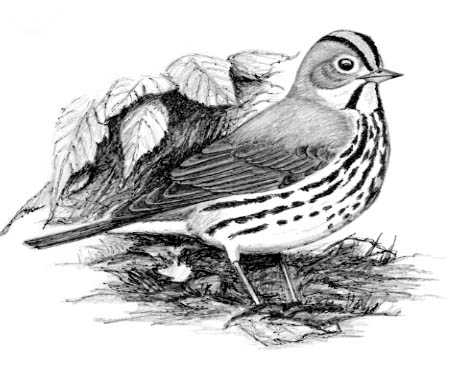
Dear Bird Folks:
Please find the enclosed photos. They are pictures of what my book claims is an Ovenbird. I had never even heard of an Ovenbird until this little bird hit my window. Are they rare around here and where would I most likely see more of them?
-Scott, Eastham
p.s. You also might want to know that the bird survived and flew away shortly after I took these pictures.
Great Pics Scott,
Everyone else out there in newspaperland will just have to take my word for it, but they really are very good pictures of a very good looking bird. Also, thanks for the “p.s.” informing us that the little bird survived his visit with your window. I would hate to be caught withholding evidence that could be used in a criminal liability suit. Martha Stewart and I would never get along in the same cell.
The Ovenbird is a complicated little bird. Its habitat, behavior and appearance are those of a thrush, so, of course, the scientists consider it a warbler. Many of us think that warblers are small birds that flit around in the tops of tall trees eating tiny insects. That’s because that’s what most warblers do. But as you know Scott, every family has a few freaks and warblers are no exception. The Ovenbird is a warbler that loves being on the ground and has no use for the tops of trees.
Believe it or not, Ovenbirds are common on Cape Cod in the summer, but you have to look for them. They are birds of the deep woods. You won’t find them scratching on your front lawn, feeding in the marsh or tanning topless in the dunes. They love to walk along the forest floor picking up insects as they go. Ovenbirds aren’t particularly shy. If you make the effort there is no reason why you won’t find one. The trouble is, in recent years, tick-phobia has kept many people from taking nature walks in any area that hasn’t been paved yet. You will need to stare down the ticks to find an Ovenbird.
The best way to find an Ovenbird is to learn it’s song. It has a very loud, distinctive and, thankfully, easy to learn song. Their booming song clearly sounds like they are yelling “teacher, teacher, teacher”. It is a familiar springtime song that brings a smile to the faces of all who can hear it. Well, all except real teachers, who have had enough of hearing “teacher, teacher, teacher” by the time spring rolls around.
Ovenbirds do indeed look like thrushes as they prowl through the understory. However, Ovenbirds are much smaller than thrushes, about the size of a sparrow. They also have a distinctive eye-ring, plus an orange stripe running down the middle of their head, giving them a punky Mohawk look.
Why would a little ground warbler be called an Ovenbird? The name comes from the bird’s nest. Ovenbirds build their nest in a slight depression on the ground. They then cover the entire nest with dried grasses and leaves, creating a dome. The birds enter and exit the dome via a small hole on the side. The domed nest reminded early naturalists of an old “Dutch oven” and since they were running out of good names they went with Ovenbird.
Note: Since I had no idea what a Dutch oven was, I decided to look it up and two things struck me. First of all, Dutch ovens look more like flower pots than ovens, but I guess calling it flower-pot-bird was too long. Secondly, did you know that there is an “International Dutch Oven Society”? I’m not kidding. They have hats, aprons and cook-offs. (And I thought bird watchers were an odd bunch.) I can’t imagine what that group is like, but I’m not going to say anything negative. I don’t want the powerful I.D.O.S. upset with me.
Ovenbirds are excellent parents and even though their nests are often victimized by cowbirds, the hard working adults provide enough food for all. Since the nest is on the ground, the young Ovenbirds only spend about eight days in the “oven”. They then get up and start walking around the woods, since they don’t have to worry about falling out of a nest in a tree.
Lastly, we should remember that nesting on the ground has some obvious disadvantages too. Ovenbird nests are often casualties of bad weather, snakes and skunks, and are occasionally attacked by warring factions of the dreaded I.D.O.S..